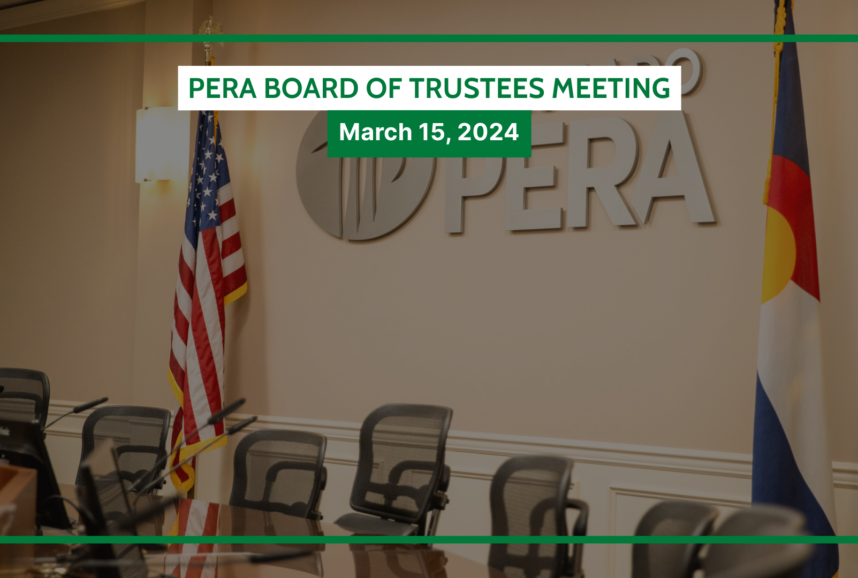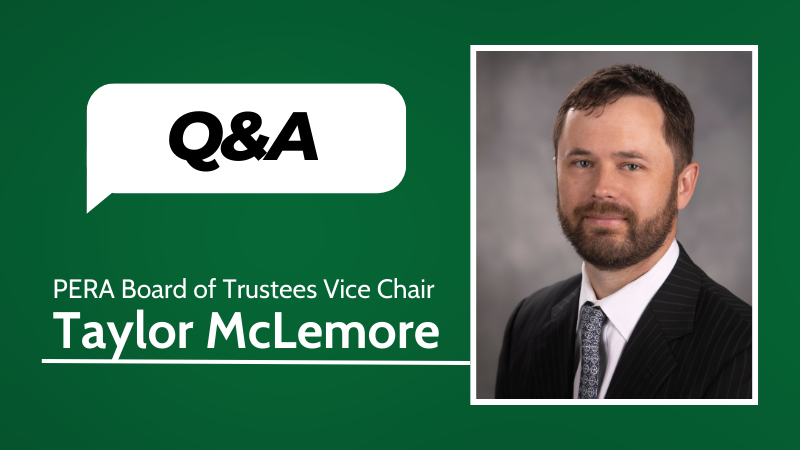Phase 2 of PERAtour, PERA’s statewide community outreach effort, wrapped up on November 2. The goal for this second round of community meetings was to share details about a recommendation the PERA Board is preparing to make to the Colorado General Assembly in the 2018 legislative session which begins on January 10. This recommended package would improve PERA’s risk profile and funded status, and improve PERA’s ability to pay benefits over the long-term. To learn more about the Board’s proposal designed to shorten the length of time it will take the plan to reach full funding, click here.
Since kicking off the second phase of PERAtour in Grand Junction on October 16, PERA staff have traversed the state to meet with more than 2,000 members, retirees, and other stakeholders in Alamosa, Aurora, Boulder, Colorado Springs, Denver, Durango, Fort Collins, Greeley, Pueblo, and Sterling. For those not able to attend a meeting in-person, we held an interactive webcast (a recording of which can be found here), and solicited questions and comments via our dedicated website and phone line.
Over the course of PERAtour, the attendees at our community meetings, as well as the countless others who chimed in via the comment form at PERAtour.org, have posed a variety of thoughtful questions and comments about the provisions of the Board’s package, and the impact they will have now and in the future. Here is a sampling of some commonly asked questions we heard:
Why is the Board recommending these changes?
PERA’s current risk level is too high and funded status too low. According to the signal light framework put into place in 2015, most PERA divisions are classified in the “orange” status, which means a corrective action should be developed. The Board’s proposed changes will result in reducing PERA’s risk profile and improving its funded status, immediately and in the long‐term.
Why weren’t changes under Senate Bill 1 sufficient to ensure PERA’s long-term sustainability?
Since 2010, the reforms contained in Senate Bill 1 have supported PERA’s mission to promote the long-term financial security of its members while maintaining the stability of the fund. However, changes in demographics (people are living longer) and economics (lower future financial market expectations) since Senate Bill 1 passed have impacted PERA’s financial standing, increasing the risk to members, taxpayers, and all of Colorado. The recommended package proposed by the PERA Board will reduce this risk and improve PERA’s funded status.
Should I retire earlier than I had planned?
The decision to retire should not be driven by the proposed changes. There are no advantages to retiring early.
Will PERA employees, Trustees, and legislators be participating in the recommended changes?
Yes. PERA employees and legislators are PERA members and retirees, as are the member-elected Trustees on the Board. Further, member-elected Trustees serve without compensation.
Will the Board still be recommending these changes in light of the recent gains in the stock market?
Yes. While global stock markets may be doing well this year, the long-term expectations for the global financial markets are not as optimistic.
Shouldn’t PERA be reducing costs before cutting benefits?
PERA’s administrative costs are very low and every expenditure fulfills some aspect of PERA’s fiduciary duty to the membership. An international pension benefits administration benchmarking firm evaluates PERA’s administrative costs and the level of customer service PERA provides each year and produces a report card that we’re proud of. Read more about this evaluation here. In addition to low administrative costs, as a large institutional investor, PERA manages the assets on behalf of 560,000 members for a low cost as well.
If you have any questions or comments about the Board’s recommended package, please fill out the submission form on the PERAtour.org website. All feedback on the proposed changes will be shared with the Board at their next meeting on November 17.
FiduciaryA person who manages money on someone else’s behalf and who has a sworn responsibility to manage those funds in the best interest of the client. BenchmarkA tool used to measure performance. For example, an investor can use a stock index as a benchmark to measure his/her own investment performance compared to the market as a whole.





1 yr no COLA not 2 yrs, we will re-evaluate this down the road
NO 1.5% CAP -KEEP 2% for current retirees
This is not fair for your current older retired PERA employees.
Make increases, but further increase the EMPLOYER contributions from 2% to 4%.
Many fortune 500 companies pay more, you want to be competitive – step the hell up. Don’t put all the burden on our employees.
Maybe we need better investors, or lengthen the time frame for solvency.
Apparently SOMEONE needs to be doing a better job.
Why can’t PERA get lower healthcare rates. Why can’t the State as a whole purchase healthcare package from a single source like regular companies – then each employee, retiree, or agency would buy in at a lower rate.
Or we need better negotiators.
I agree with your comments.
I, for one, lost money on the Stock Market this year (I gained on Tesla and a few other companies, but lost on too many stocks…); however, my son (NN) is making nearly 30% on TIAA ‘screened’ Mutual Funds this year… He is not an expert, but followed some good advice (some of it, ironically, from me!… like, for example, what I’ve just mentioned above)….
So, WHERE ARE the experts, who should repeat what my son did?…
Stock market up almost since Trump was elected
Has Pete?
I think that Secure Pera and the board had their minds made up about possible options six months ago and have used these “input forums “ to back up decisions that have already been made months ago. The idea of punishing retirees for the failures of the political class is ethically reprehensible. Promises have been broken, commitments have not been kept. I am certain all retirees will remember this come election day.
I totally agree with your comments. It is not fair nor right to decrease the benefits of those of us who are already retired and too old to go back to work.
I am drawing a PERA retirement. All, including us retiree’s, must contribute to fix the shortfall. I would rather give up some now versus not have a monthly check in my later years. Your statement ” It is not fair nor right to decrease the benefits of those of us who are already retired and too old to go back to work.” is saying don’t cut my benefits but make somebody else pay for my share. Be thankful for what you have!
I am a retiree as well and believe in a reasonable shared burden. I want solvency, not just for myself, but for future beneficiaries as well. As an aside, I would suggest that PERA look at a 20 year retirement for those in the entire enforcement series. I suspect that actuaries would show that the stress on this series leads to greater illness and deceased lifespan. I would suggest that PERA allow these members to pay a higher monthly percentage to receive this 20 year retirement. This could be set up so there is no additional cost to the plan.
Are these the questions offered?
There are more no doubt……….
This single quote from your post: “Since 2010, the reforms contained in Senate Bill 1 have supported PERA’s mission to promote the long-term financial security of its members while maintaining the stability of the fund. However, changes in demographics (people are living longer) and economics (lower future financial market expectations) since Senate Bill 1 passed have impacted PERA’s financial standing, increasing the risk to members, taxpayers, and all of Colorado. The recommended package proposed by the PERA Board will reduce this risk and improve PERA’s funded status.”
How can you ask for support from current retirees when that statement is demonstrably false ?
1. Life expectancy in 2010 is no lower than life expectancy in 2017, some tables show minor decreases in life expectancy.
2. The Number of Retirees who LOST the guaranteed 3.5 % annual Benefit increase is smaller today than it was in 2010 due to “attrition”. That pool of retirees is dying off, and will continue to do so.
3. There is no need for a 100% funding of all debts IF the population to be paid benefits is living longer, the obligation is a long -term obligation and the funds for complete payout are spread over two – three decades.
A healthy pension plan needs only to achieve an 75- 85 % funded liability, at any given moment. Changes to employer contribution, tax funding and fiduciary planning GOING FORWARD should protect retirees already fully vested underlying on guaranteed benefits from contractual agreements.
4. A weakened and untrustworthy system of benefits hampers attraction and retention of quality teachers, cops and others. The current teacher shortage can be directly attributed to the reduction of benefits and attraction of pension compensation.
5. There is no credibility to any claim that Colorado is in economic distress. Revenues from stock market, revenues from recreational marijuana, and a massive increase in property values has occurred SINCE 2010. To claim otherwise defies reason, and available data.
Finally, when it is claimed that Senate Bill 1 aims to “sustain the long term stability”, we recognize that means ” without any further input from the taxpayer”. That would be wonderful,… but the truth is, from time to time ( as in any commodity or service) prices must increase . The beneficiaries of the PUBLIC EMPLOYEES of colorado , i.e . taxpayers, may need to see an increase in cost to educate, protect and serve, and perform all of the other functions that are provided to the citizens for their tax dollars. Fully vested and Fixed income retirees should never be retro-actively tasked to shoulder the burden of a negligent constituency, failing to live up to its contractual agreements.
Thank you for your comments, Mr. Thorpe. Briefly, in response to your concerns:
1. PERA retirees are living longer, especially those who retired from the School Division. PERA uses mortality tables that most closely mirror the actual experience of the membership.
2. You are correct that the number of retirees who received the 3.5% Annual Increase is growing smaller. PERA’s actuaries have taken this into account when determining the amortization periods of the trusts.
3. The Board’s funding policy has a goal of 100% funding in 30 years.
4. The Board was aware of the need to maintain the attraction and retention features of the PERA retirement plan. Certainly other factors such as salary, work environment, and housing costs must be included in any assessment of the desirability of public sector careers. We believe that the PERA plan remains a competitive and attractive feature for those considering public employment.
5. Yes, the economy in Colorado is doing well. However, the long-term global economic forecast is not as optimistic.
How can the CEO get a big pay raise and big bonus when he is not performing well. He is ultimately responsible for how PERA is doing. We are living for a year in what he makes in a month or two.
Dear Ms. Todd,
The PERA Board, based on a number of factors and with the input of external compensation consultants, determines the compensation of the PERA Executive Director. The Executive Director’s performance is measured in the areas of the 23 initiatives set forth in the Board’s Strategic Plan as well as five key areas: Communications with Key Constituents, Operations/Management, Asset Management, Legislative Issues, and Board
Relationship. The Executive Director oversees a staff of 300+, has oversight of $47 billion in defined benefit plan assets, and another $4 billion in defined contribution plan assets, in addition to the oversight of a large retiree health care plan. PERA’s administrative costs are extremely low as evaluated by an external consulting firm. Read more about that here: https://peraontheissues.com/index.php/2017/10/04/how-does-pera-measure-up/
Retirees on fixed incomes should not be so drastically affected by COLA
Retirees on fixed incomes should not be so drastically affected by COLA. Not equitable for what we signed up for in the 1960’s
I agree with many of the responses, especially by Bill K and Barry T (though not all points Barry). It is true that statistically, since 2010, we are not living any longer. However younger generations may not live as long as current baby boomers for several reasons, including the diabetes epidemic, and the very real prospect of lack of healthcare and preventive care. I did not believe that agreeing to include the school teachers in PERA would be a wise financial decision simply b/c of the sheer numbers of teachers. I do believe that older retirees, including my generation of baby boomers will bear the burden of the “shared sacrifice/responsibility” concept. (AND, we won’t be able to recover from these financial losses.) Its a great marketing catch-phrase for state taxpayers, and even for elected lawmakers, but I too, am a taxpayer and I’m certain that my contribution to PERA is far lower than the % of my taxes going to education. I do not resent paying these taxes for either purpose. As a woman, however, I must admit to the fear and trepidation I feel as the annual AI’s are reduced, possibly dropped to zero, the very real possibility of the reduction of Medicare benefits and increased premiums, the elimination of Medicaid, etc. I took measures to help ensure long-term financial viability in retirement, including to stay in a state position when I could have earned a higher salary in the private sector. I am not competitive in the workforce now, especially with millennials entering in record numbers, many with master’s degrees. My retirement plan didn’t include the possibility of being a “greeter” at Walmart! The prospect of being a poor, old woman looms large on the horizon for me and should be one of great concern to all female PERA retirees since we are likely to outlive our male counterparts. I would advocate a higher contribution be paid by employers, especially DPS (the $20-M referenced by someone? factual???) I would venture a guess that the PERA board members all earn salaries that would qualify for a much higher than average annual PERA benefit, if they met eligibility qualifications. So, who is really advocating for retirees and specifically female retirees? Rather than dropping the AI to 1.5%, are there intermediate steps that can be taken to spare the hardest hit among these retirees? Since marijuana is a booming business in the state, perhaps that industry should pay higher taxes–I don’t believe it will discourage its consumers or the tourists coming to Colorado specifically for that product! I encourage PERA board members to go back to the drawing board and fight Hickenlooper’s PERA proposals. This is an easy call for the governor since he’s on his way out. Do we need better lobbyists to make our case to lawmakers? I can move to a lesser expensive state and take my PERA money with me–who loses then?
Hello Linda,
To clarify, the PERA trusts are independent of each other in terms of demographics (mortality). Teachers represent about half of the members in the School Division, and there are division trust funds for state employees, judges, Denver Public Schools employees, and local government workers.
Why is the PERA Board silent about the forced spend down of the 110% funding status of Pera pension fund in 2000, by Governor Olson and the Republican majority in the legislature ? This must be brought to the public attention AND made clear to the state population. PERA would be in much better condition today had it refused to comply with the Governor and taken him and the legislature to court!
Mr. Hawk,
PERA was fully funded at the end of 1999 and 2000. Keep in mind these were the only two years since PERA was created in 1931 that this occurred. As PERA reached full funding, benefits were enhanced and contributions were reduced by the Colorado General Assembly. The PERA Board is a forward-looking body that has a fiduciary responsibility to the 560,000 current and former public employees in Colorado and the Board’s legislative proposal is designed to ensure the retirement plan is financially healthy for Colorado’s current, former, and future public workers and their employers.